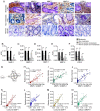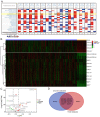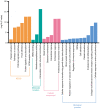Prognostic significance of abnormal matrix collagen remodeling in colorectal cancer based on histologic and bioinformatics analysis
- PMID: 32945508
- PMCID: PMC7448414
- DOI: 10.3892/or.2020.7729
Prognostic significance of abnormal matrix collagen remodeling in colorectal cancer based on histologic and bioinformatics analysis
Abstract
As the major component of the tumor matrix, collagen greatly influences tumor invasion and prognosis. The present study compared the remodeling of collagen and collagenase in 56 patients with colorectal cancer (CRC) using Sirius red stain and immunohistochemistry, exploring the relationship between collagen remodeling and the prognosis of CRC. Weak or strong changes in collagen fiber arrangement in birefringence were observed. With the exception of a higher density, weak changes equated to a similar arrangement in normal collagen, while strong changes facilitated cross‑linking into bundles. Compared with normal tissues, collagen I (COL I) and III (COL III) deposition was significantly increased in CRC tissues, and was positively correlated with the metastasis status. In tissues without distant metastasis, collagen IV (COL IV) levels were higher than that in normal tissues, while in tissues with distant metastasis, collagen IV expression was significantly lower. Furthermore, the expression of matrix metalloproteinase (MMP)‑1, MMP‑2, MMP‑7, MMP‑9 and lysyl oxidase‑like 2 (LOXL2) was found to be elevated in the cancer stroma, which contributed to the hyperactive remodeling of collagen. The association between collagen‑related genes and the occurrence and prognosis of CRC were analyzed using biometric databases. The results indicated that patients with upregulated expression of a combination of coding genes for collagen and collagenase exhibited poorer overall survival times. The coding genes COL1A1‑2, COL3A1, COL4A3, COL4A6 and MMP2 may therefore be used as biomarkers to predict the prognosis of patients with CRC. Furthermore, the results of Gene Ontology (GO) and Kyoto Encyclopedia of Genes and Genomes (KEGG) analysis suggest that collagen may promote tumor development by activating platelets. Collectively, the abnormal collagen remodeling, including associated protein and coding genes is associated with the tumorigenesis and metastasis, affecting the prognosis of patients with CRC.
Keywords: collagen; matrix metalloproteinase; lysyl oxidase-like 2; Oncomine; TCGA; GEO.
Figures







Similar articles
-
Cold exposure and capsaicin promote 1,2-dimethylhyrazine-induced colon carcinogenesis in rats correlates with extracellular matrix remodeling.World J Gastroenterol. 2021 Oct 21;27(39):6615-6630. doi: 10.3748/wjg.v27.i39.6615. World J Gastroenterol. 2021. PMID: 34754156 Free PMC article.
-
Lysyl oxidase-like 2 is highly expressed in colorectal cancer cells and promotes the development of colorectal cancer.Oncol Rep. 2018 Aug;40(2):932-942. doi: 10.3892/or.2018.6452. Epub 2018 May 21. Oncol Rep. 2018. PMID: 29845296
-
Epithelial but not stromal expression of collagen alpha-1(III) is a diagnostic and prognostic indicator of colorectal carcinoma.Oncotarget. 2016 Feb 23;7(8):8823-38. doi: 10.18632/oncotarget.6815. Oncotarget. 2016. PMID: 26741506 Free PMC article.
-
Matrix metalloproteinase (MMP) -2, -7 and -9 promoter polymorphisms in colorectal cancer in ethnic Kashmiri population - A case-control study and a mini review.Gene. 2016 Sep 1;589(1):81-89. doi: 10.1016/j.gene.2016.05.028. Epub 2016 May 21. Gene. 2016. PMID: 27222481 Review.
-
[Matrix metalloproteinases and colorectal cancer].Med Klin (Munich). 2003 Dec 15;98(12):763-70. doi: 10.1007/s00063-003-1322-5. Med Klin (Munich). 2003. PMID: 14685678 Review. German.
Cited by
-
Extracellular matrix: unlocking new avenues in cancer treatment.Biomark Res. 2025 May 27;13(1):78. doi: 10.1186/s40364-025-00757-3. Biomark Res. 2025. PMID: 40426238 Free PMC article. Review.
-
Unraveling the Effects of Epigallocatechin-3-gallate on Hepatocellular Carcinoma Cells: A Comparative Analysis of Monolayer vs Multicellular Tumor Spheroids.ACS Omega. 2025 Jul 31;10(31):34238-34253. doi: 10.1021/acsomega.5c00839. eCollection 2025 Aug 12. ACS Omega. 2025. PMID: 40821580 Free PMC article.
-
Exploring the impact of TGF-β family gene mutations and expression on skin wound healing and tissue repair.Int Wound J. 2024 Apr;21(4):e14596. doi: 10.1111/iwj.14596. Epub 2023 Dec 27. Int Wound J. 2024. Retraction in: Int Wound J. 2025 Apr;22(4):e70430. doi: 10.1111/iwj.70430. PMID: 38151761 Free PMC article. Retracted.
-
A novel prognostic model based on urea cycle-related gene signature for colorectal cancer.Front Surg. 2022 Oct 21;9:1027655. doi: 10.3389/fsurg.2022.1027655. eCollection 2022. Front Surg. 2022. PMID: 36338624 Free PMC article.
-
The extracellular matrix alteration, implication in modulation of drug resistance mechanism: friends or foes?J Exp Clin Cancer Res. 2022 Sep 16;41(1):276. doi: 10.1186/s13046-022-02484-1. J Exp Clin Cancer Res. 2022. PMID: 36114508 Free PMC article. Review.
References
MeSH terms
Substances
LinkOut - more resources
Full Text Sources
Medical
Molecular Biology Databases
Research Materials
Miscellaneous

